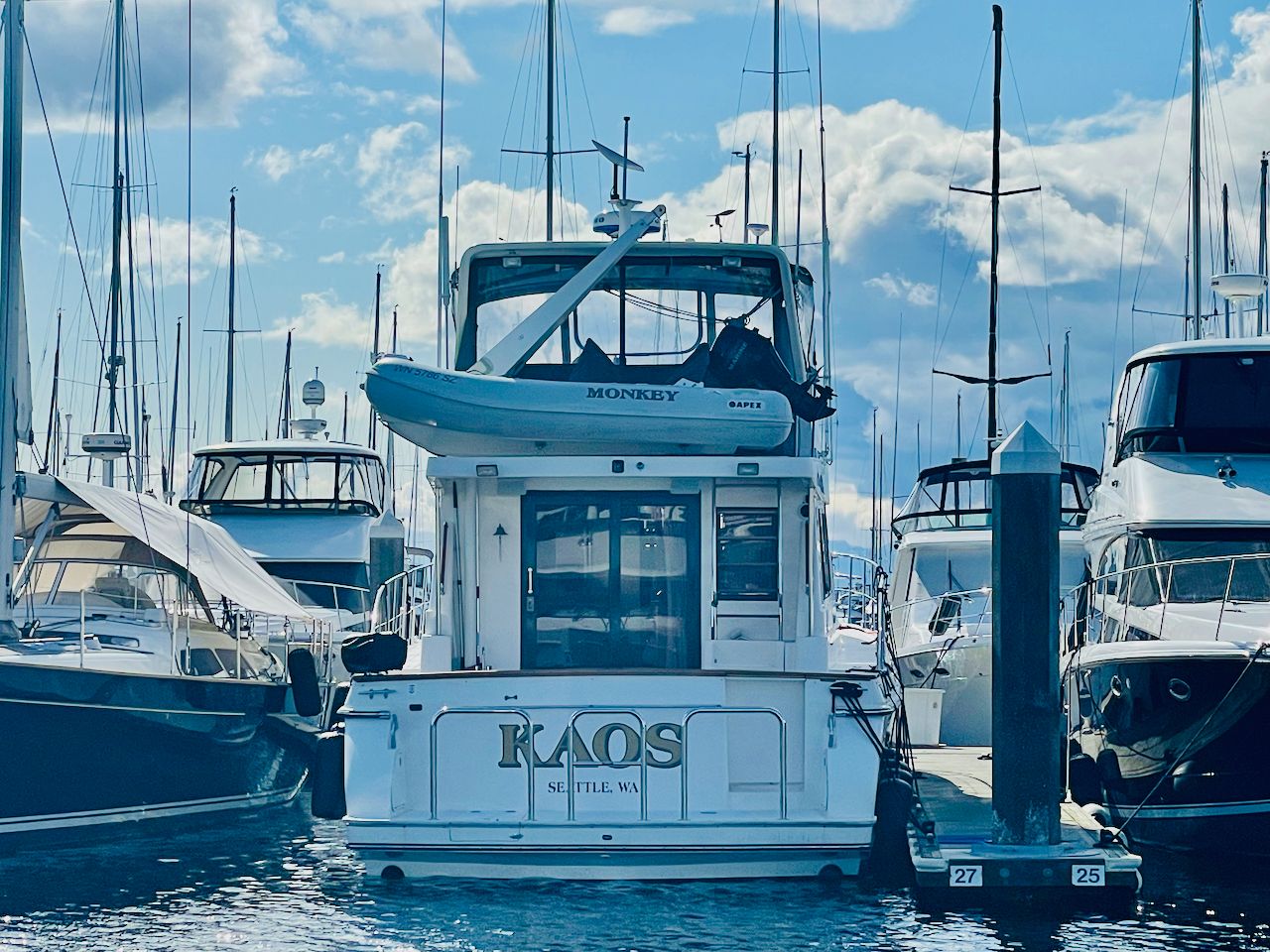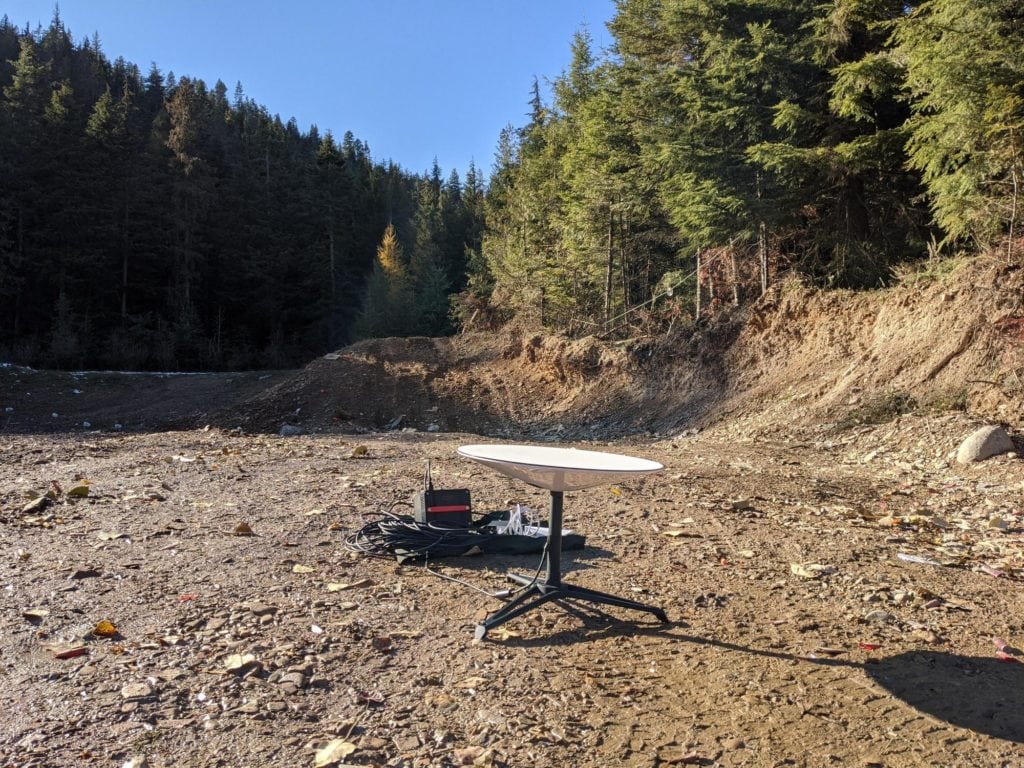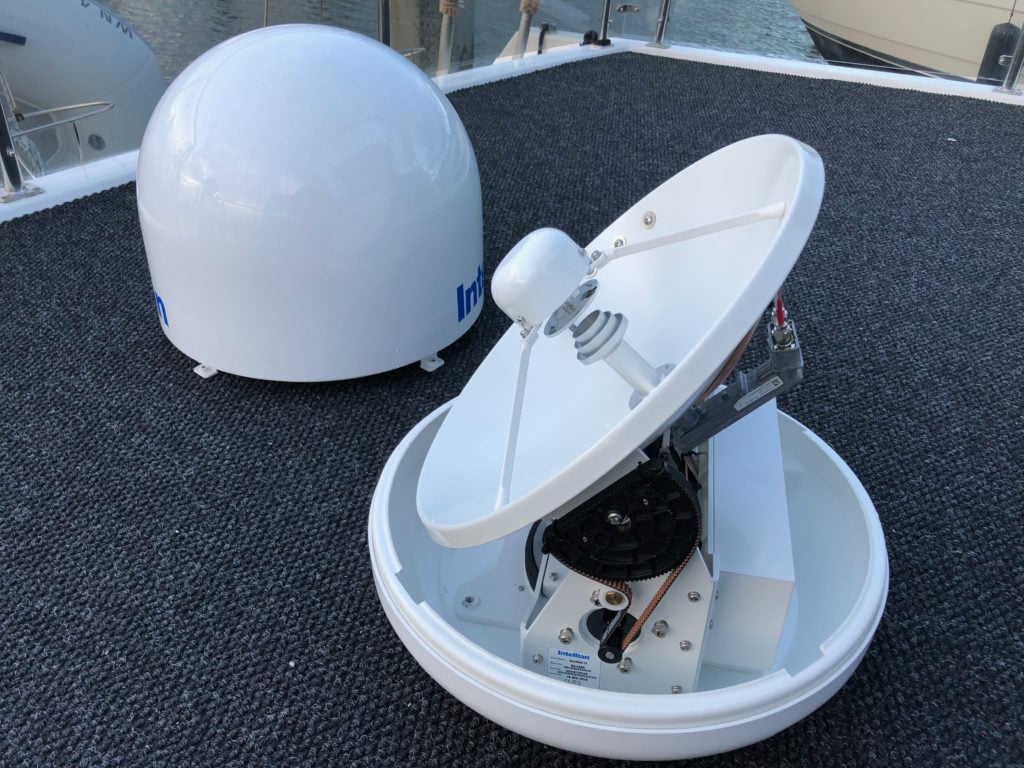
Many folks are asking about whether Starlink is a viable alternative for internet connectivity on the boat. I'll cover what I know and link to some other useful bits of info.
What is Starlink?
Starlink is a satellite-based internet solution being created by SpaceX which has been in beta test for a while. It's based on a “constellation” concept using low earth orbit (LEO) satellites only about 300 miles up.
The big advantage of something in low earth orbit is that it is closer to you and allows for much faster speeds and lower latency. The bad part is that means that the satellites are always moving, sort of like in a “train”, and that means the dish on the ground has to track a band where those satellites will pass through, which is more complicated to make work.

SpaceX has been launching huge quantities of satellites for a while now, and have coverage in very specific areas. That is changing as they continue to launch and configure more satellites.
In the last few weeks, folks who signed up to be notified of the service being available in their area have been getting emails allowing them to place an order. While that is encouraging, release dates are still pretty high level – some regions are being told mid-2021, while others are being told later-2021. I don't have any more detailed information on release dates than what is public, but it does seem like many regions are going to see production versions of Starlink this year.
How is this different than traditional satellite?
Starlink satellites as mentioned above are in a low earth orbit of about 300 miles. Traditional satellite internet solutions are much, much higher – 22,000 miles! Those extra miles add a huge amount of latency, or delay for the signal to go between the two points, and dramatically reduce the bandwidth you can use.
In addition, traditional satellite systems are usually setup to track a specific single satellite once you have a connection, rather than a series of them passing by.
What does it cost now?
Starlink costs $499 for the hardware and $99/month which appears to be unlimited, but remember, things are still in beta. I'm sure there will be some sort of overall caps, and in busy areas with multiple users, speeds will slow down. However, this is pricing for residential systems, not mobile or boat systems.
Residential satellite using traditional, non-Starlink methods from companies like HughesNet and Viasat cost $100 or more for a data-capped plan that only has 10-35Mbps speeds. These are much higher latency systems, sometimes requiring a phone line to work, and these are residential solutions, not mobile or maritime.
What will it cost for boats?
There isn't a mobile version of Starlink, so there isn't any pricing yet, and I doubt we will have any for a while. The big question is whether it will be cheaper than current satellite internet solutions for boats, and I think this is a big grey area.
Residential internet has subsidies and discounts from local and federal governments, while mobile satellite internet on a boat does not. That means your per-month operating cost is not going to be $99 – it will be much higher on a boat.
Maritime satellite plans are quite expensive with current solutions. You can expect a minimum of $1000/month for most basic services, all the way up to $10k and beyond depending on your usage.
The cost of a static dish is much cheaper than one that rotates and tracks things dynamically, works in a salt environment, and runs off of DC power more efficiently. So the hardware is going to cost more. Hopefully not as expensive as current mobile/marine solutions – those can easily be $15k for a good KVH setup, and much more.
So I don't think that you'll see Starlink mobile/maritime priced at $99/month. It takes more expensive satellites to provide service in remote locations that likely won't be a priority for ground stations (see below), and you'll need a more complicated antenna to make it work.
I do believe that Starlink will revolutionize satellite internet (it already has essentially) and drive prices down everywhere, but to expect it to be cheaper than current satellite solutions, or cheaper than LTE solutions, is just not something I think is going to happen in the short term. New technology always costs more, and nothing on a boat ever seems to be cheap!
The folks over at Sea-Tech Systems have written up a good article on using Starlink aboard which has some info in it backing up the details above, as well as an excellent article on S/V Delos Viasat system and the true cost of something that you can buy today.
What about speeds?
Beta testers have been seeing anywhere from 50-150Mbps download speeds, and uploads up to 25Mbps. The latency is what is amazing – given that the Starlink satellites are much closer than traditional satellite internet (300 miles versus 22,000), you end up with a shorter journey for your data, which results in latencies at or slightly above LTE.
There have also been reports 10-30 second outages as one satellite hands off to another, although this is suspected to be something that will improve with software tweaks. Many people who have used it with Zoom and other latency sensitive programs like gaming have said the outages cause major interruptions, so there's still work to be done before this can replace existing solutions.
However, the speeds in general have been amazing compared to traditional satellite, and as Starlink continue to make improvements, it will only get better. The speeds in general are comparable to very good LTE signals both in terms of download and upload, and slightly higher in terms of latency. A phenomenal achievement!
What are ground stations?
The constellations of satellites need some way to actually get an internet signal, and that is done using a ground station. Part of the challenge with a train design is that you need a lot more ground stations that the satellites can point down at and get their internet signal from since they are moving across the sky constantly. A more traditional satellite really only needs one ground station since it is essentially staying in a fixed position above. Starlink is building hundreds of these ground stations which will take quite a bit of time.
Keep in mind that if you are offshore, Starlink won't have any way of connecting to a ground station, and may not be a viable technology for some time. Newer versions of the satellites use lasers between each one, allowing each satellite in a train to communicate to the one next in line, thereby connecting them together in a string until one has a ground station.
So, while ground stations might work in populated areas, more remote areas that you might cruise in could potentially not have one in sight of a train right now, or may not have the new updated laser satellites.
Have you tested it?
I've done a couple of days worth of tests with a unit that belonged to a beta tester at their house. I was not a beta tester (I tried to be!) and do not have a unit at this time. However, a couple of days of testing is a far cry from my usual test methodology, so my first impressions are just that – first impressions and not a full set of tests.

Did it work?
I tested the unit in a stationary location and it worked fine, of course, and I was impressed with the throughput and latency. I simulated being at anchor by using a slowly rotating turntable and it did not work hardly at all, as I would expect. Others have tested on cars and vans and it has not worked there either in any reliable form.

Why wouldn't it work?
The primary reason is that the current solution was built to be stationary. The receiver is designed to find a track or train and lock onto that and not move. Any sort of movement at anchor or on a mooring, or while underway, is going to mess up the lock that the receiver has.
Some have theorized that a software solution would fix this given that this is a phased array antenna being used, and that is possible. There's even been some tests on jets and ships that have shown that it works, but the details of how those tests were performed aren't 100% clear.
I think it might be more likely to be a combination of software improvements and perhaps a small gimbal or other device to help in extreme situations, but these are all just guesses.

There may be a need for a similar mount to what traditional satellite systems are using, but it is too early to tell.
When will there be a mobile solution?
Probably not for a year or longer. The priority for Starlink is residences that don't have high speed internet now, both in the US and globally. Mobile users come after that somewhere. There have been no official announcements, no timelines, nothing, so I would not expect it to happen anytime soon. Launching a global constellation of satellite trains + ground stations is a big job, and mobile just isn't something they're addressing yet.
Most of Earth by end of year, all by next year, then it’s about densifying coverage.
— Elon Musk (@elonmusk) February 22, 2021
Important to note that cellular will always have the advantage in dense urban areas.
Satellites are best for low to medium population density areas.
In a recent tweet from Elon Musk, he replied to a request for a coverage map that “Most of Earth by” end of 2021 will be covered, and “all by” 2022 for their standard service. Getting info from Starlink in general is hard, and tweets and social media posts have been very common for this rollout. We can't be sure this means all of the entire world, or just the “low to medium population density areas” which could mean remote areas, like where you cruise, are not even scheduled to have coverage by 2022.
So, even if there is a mobile solution available, the areas you cruise in may not have coverage/ground stations/be supported.
Read the Starlink FAQ!
Starlink has created a FAQ that covers a number of questions, two of which are critical for anyone considering using it on a boat:
Can I change my service address?
Starlink is only approved for use at the Service Address you provided when you signed up on starlink.com. When placing your initial order, you will have the option to select a different Shipping Address to receive your Starlink packages.
If you have already ordered Starlink and your service address is changing please contact our Support team by logging into your account.
What this is telling me is that they really want you to keep it at the address you ordered it for.
Can I travel with Starlink, or move it to a different address?
Starlink satellites are scheduled to send internet down to all users within a designated area on the ground. This designated area is referred to as a cell.
Your Starlink is assigned to a single cell. If you move your Starlink outside of its assigned cell, a satellite will not be scheduled to serve your Starlink and you will not receive internet. This is constrained by geometry and is not arbitrary geofencing.
So…. essentially if you move it, it won't work. So probably not a good idea to buy one and stick it on a boat and go cruising. I'm sure some folks will figure out how to get around this, but I would not be surprised if this is a violation of their terms of service, and you could have your account cancelled as a result…
Should I wait to buy LTE stuff?
If you are starting new or need to upgrade, I wouldn't wait. LTE works now and will likely be a prime technology for several years to come. Remember, ground stations aren't going to be built everywhere, so LTE may be the only decently affordable way to stay online in remote locations.
No mobile solution has been created for Starlink, and according to their FAQ, you're not supposed to move it, so you can't even hack one together without having issues. LTE or traditional satellite remain the primary choice, and will likely be that way for a couple of years.
Bottom Line
- Starlink is not ready for mobile use yet, and there are no concrete details about how or when this will work.
- The cost is also unknown, and I predict it will not be as cheap as residential service.
- Ground stations or laser enabled satellites will need to be available in more remote regions that you might cruise in and there are no timelines for that either.
- Starlink's priority is residential customers in low to medium density areas, which means the above items might not be addressed for a year or more.
- LTE is still the primary technology to use for higher bandwidth, lower latency coastal cruising needs.
- Consider the Starlink FAQ – you aren't supposed to move it or use it on a mobile platform.
Archived Comments
These are read only comments from the old system. Scroll down to participate in SeaBits Discussions, our new interactive forum attached to each article.
David Geller
February 27, 2021 at 10:33 pm
I think, for the near-term, it represents a superb dock-based solutions and have heard of some boaters having success with that form of use. I do expect Starlink (and perhaps Blue Origin’s constellation at some point) to disrupt the traditional maritime communications space. I’m counting on it. I’m also hopeful of two things – that a gimbaled solution is not going to be that difficult to achieve (the mechanisms are fairly simple and we have many examples of low cost assemblies – like the KVH unit I have on my boat). The second is that Starlink will, one day, have sat-to-sat-to-ground-station communications. That will dramatically increase not only the coverage area but, ultimately, the latency. It’s anticipated that when that technology is deployed communications between Seattle and London, for example, will be faster than through traditional terrestrial networks. In the meantime, for the dock, I’m hoping T-Mobile makes their Home Internet (https://www.t-mobile.com/isp) product available. For $50 that seems like an awesome way to keep my boat connected while at the dock.
- Steve Mitchell
February 28, 2021 at 9:06 am
I agree that at a dock it makes a lot of sense for a permanent connection.
I’m also very excited about Starlink disrupting the maritime industry. Paying $18,000 for 150GB of data through a provider like KVH, and really slow high latency data at that, is highway robbery. The hardware needed just to do this is also far too overpriced, and has not come down in cost in years.
I don’t think coming up with a gimbal/software/solution to the underway/anchor problem is going to be that big – the point of the article was that it’s not working now, and it isn’t something that is likely to be fixed with a simple software upgrade.
I am very much looking forward to seeing new features and even better performance as Starlink continues to roll out. Its still early days for their solution, but they’ve demonstrated that they’ve approached this problem from a completely different angle from traditional methods. Better latency, faster speeds, and more coverage are all things they’ve alluded to in various AMA sessions, and I can’t wait to see what happens!
Owen Anderson
February 28, 2021 at 12:04 am
re: movement at anchor, I think you’re underestimating the effect of phased-array antennas. The key idea here is that the “dish” consists of an array of small antennas, and by operating them simultaneously slightly out of phase with each other, one can use self-interference to effectively “steer” the antenna’s beam in a direction other than straight ahead. And it’s a purely electronic process, not mechanical, so response time can be very good.
What remains to be seen is how wide of beam steering angle current Starlink dishes can handle before they need mechanical adjustment. The wider it is, the more and faster movement they’ll be able to handle. Starlink has demonstrated Starlink operating on fighter jets in movement (though presumably NOT with consumer-class hardware), so it’s definitely not *impossible*.
I’m optimistic that Starlink will be a viable option for at-anchor internet in remote locations in the 2-3 year time frame. I’m also not quite as pessimistic as you on pricing. I expect mobile use to cost more than stationary, but I’d be shocked if it ends up being anywhere close to the cost of current satellite internet. The incremental cost to Starlink for a mobile customers aren’t a lot more than a fixed customer – it’s overwhelming just the R&D and capital costs of deploying the constellation in the first place.
- Steve Mitchell
February 28, 2021 at 8:57 am
I’m aware of how the antenna works and its design, but so far, no one has shown that it can work the way that is being theorized. Perhaps that is because the software doesn’t know how to do this yet, which is completely possible. Even if it is capable of handling the movement at anchor, I think the yaw and pitch movement while underway is going to be another level of challenge. I’m also assuming that the fighter jet test included not only a different/bigger/better array, but also some sort of mount that is not available to us yet either.
My point overall is that the current user terminal is not likely going to be the thing you use on a boat. Starlink have even admitted that the power usage (right around 100W) is too high for mobile applications, and that they intend on improving it through different hardware outside of the dish part.
I think the exciting thing is the fact that someone has designed something completely new from the ground up with a different approach to solving the internet problem, and it opens up a wealth of potential solutions for us on boats – when they’re designed and delivered. That’s the point of this article – Starlink isn’t ready for boats quite yet, but it is promising.
I think the 2-3 year timeframe matches perfectly with my expectations as well. It’s going to take time to figure out the software, hardware, and business model, and for it to become a priority with Starlink.
I’m less optimistic about the price of a maritime solution being as cheap as LTE because, well, Starlink is a company trying to make a profit. They’ve demonstrated they’re going to offer a reasonably priced residential, rural internet service. That market wouldn’t support something atrociously expensive, but the marine market has an established pricing model for internet access being very expensive in the satellite world. I don’t think it will be in the realm of the current satellite pricing, but I do think it will be several times more expensive than any current LTE solution for the foreseeable future.
Owen Anderson
March 8, 2021 at 3:01 pm
Starlink just filed with the FCC for licensing for mobile installations: https://fcc.report/IBFS/SES-LIC-INTR2021-00934
Some analysis here: https://arstechnica.com/information-technology/2021/03/spacex-plans-starlink-broadband-for-cars-boats-and-planes/
Mike Harrington
March 8, 2021 at 6:47 pm
On Friday, Starlink submitted an application to extend their license to allow for earth stations on airplanes, vehicles, and “ships”!
https://www.geekwire.com/2021/spacex-seeks-fcc-ok-extend-starlink-satellite-data-service-vehicles-boats-planes/
Neil Ramsey
March 19, 2021 at 11:50 am
Starlink does work on a boat that is moored. Our sailboat wanders and wiggles in the wind and I have the dish temporarily mounted with a piece of PVC pipe. There is horizontal movement of 18 inches and some vertical and angular movement.
The speed does not appear to be affected at all.
I suspect that SpaceX had more than “theory” when they started cranking these things out.
- Steve Mitchell
March 19, 2021 at 9:50 pm
Thanks for the report! In my testing at a dock things worked fine, even with small movements due to wakes and lines stretching and such.
Mike Harrington
April 16, 2021 at 1:47 pm
“Later this year…”
https://www.pcmag.com/news/movable-satellite-internet-spacex-to-lift-geo-restriction-on-starlink-dishes?amp=true
- Steve Mitchell
April 16, 2021 at 1:55 pm
There were a number of comments and Twitter things the last 24 hours…. It does seem like they may make Starlink available to land-based things later this year. Still no confirmation about marine solutions or if they might not be ready yet.
Two things to consider though:
Starlink announced a lot of the “cells” are full until 2022 so they are slowing down beta testers, and some folks who have tried to change their address to a new location have found zero capacity available, so there may be an additional wait while they spin up more capacity.
Elon Musk is very aggressive with his tweets and has often said things will be available before they really are, or only available to existing testers, etc. so I doubt we’ll all be using Starlink later this year on the boat. Here’s hoping, though!
Enes Kirimi
May 2, 2021 at 4:13 am
There has been a tweet this March from Elon Musk about StarLink on mobile vehicles that is interesting. He mentions StarLink on ships and RV’s: https://twitter.com/elonmusk/status/1369051431903268865
My question now is whether this solution would be good for sailboats as well, without a manageable-sized antenna etc.. There is a plan in place for mobile solutions at least, which is very promising.
Ian Crosby
May 19, 2021 at 10:21 pm
Not soon enough for Alaska this summer. In the meantime an Iridium Certus/Thales rental costs what it costs to be able to work remotely from Glacier Bay with no cruise ships.
treysis
June 2, 2021 at 4:38 am
Don’t know about the US, but here in Germany, there’s no subsidizing of Starlink by the government or local communities. So this argument is invalid in the cost assumption. It might be a bit more expensive, especially once Starlink goes out of beta, but I firmly believe it will be much less than 200 USD per month. As you mentioned, movement could be compensated (at least in less rough waters) with a gimbal-sort-of-solution. My biggest concern that we share is actually the energy consumption. If you don’t have a million-dollar yacht, your battery probably will be too small for extended use. Hoping for more energy-efficient versions of Dishy McFlatface.
Neil Ramsey
July 15, 2021 at 11:16 am
It draws about 10 amps so 4 or 5 hours of use per day isn’t insurmountable.
- Steve Mitchell
July 15, 2021 at 1:33 pm
From what I’ve seen, at it’s peak it can use 110W of AC power which is about 1 amp of AC, or 11 amps of DC power. Compared to traditional gyro/gimbaled satellite that is pretty in line with some of the smaller ones, and much less than some of the big ones.
Running it all day will definitely be a challenge for smaller battery banks / boats. At an average of 10 amps of continuous DC power, that’s pretty close to what a fridge will pull, which is often times the largest consumer.


